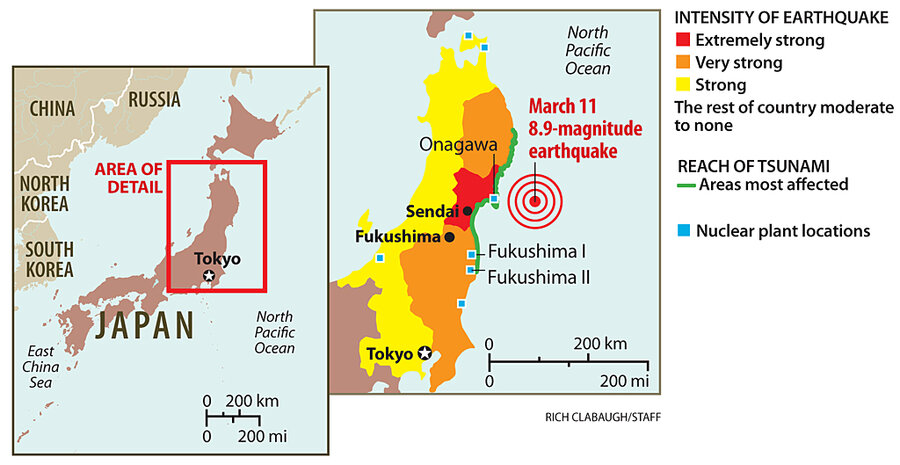Meltdown 101: What is a nuclear reactor meltdown?
| Washington
Combine the word “nuclear” with the word “meltdown,” and you get something which sounds really scary to the average person. But all those scientists on cable news talking about what’s happening in Japan aren’t always clear about what a nuclear meltdown is, and isn’t. Is it an explosion? Will it burn a hole to the center of the earth? Does it spray radioactive stuff into the air, poisoning the surrounding landscape?
The answers: No, it’s not an explosion, though there can be some explosive side effects. We’ve seen that already in Japan, where a couple of reactor buildings have blown up. No, it would not burn a hole to the center of the earth. The movie “The China Syndrome,” which popularized that notion, was fiction. And whether a meltdown is an environmental disaster depends on a number of factors, including how extensive it is, and how well the nuclear power plant's safety features can contain it.
First, let’s consider what a nuclear reactor is: a giant, glowing red-hot coal. That’s a simplistic way of describing it, anyway. Nuclear reactors, just like fossil fuel-burning power plants, make electricity by heating up water so it turns into steam and drives a turbine, which powers a generator.
To use another analogy, the nuclear fission which creates this heat is a bit like the chaos you’d get if you toppled a giant pyramid of canned tomatoes. First, one can would fall, and then it would bounce off several more cans, knocking those over, and then they’d all bounce downhill, creating an ever-expanding chain reaction. And each time a can hit another can, it would produce a spark of heat.
In Japan, this chain reaction stopped at the time of the earthquake, when the reactors shut down as a safety response. But nuclear fission produces such enormous amounts of heat that it takes a long time for the reactor core to cool. Plus, the fissile material keeps giving off what’s called “decay heat” as it continues to emit radiation. Right after shutdown, a nuclear reactor is still producing large amounts of heat, so you’ve got a pretty big job keeping the whole thing cool.
Normally that’s done by circulating water around the core. But in Japan, the earthquake knocked out all means of moving this coolant. Once that happens, the water can turn to steam, laced with hydrogen and other explosive elements. This increases pressure in the containment building. That’s what caused the building explosions we’ve seen so far.
Japanese nuclear officials are desperately pumping sea water into the reactor buildings to try and cool things off. But the pressure from the steam and continued heat makes that much more difficult to do than it sounds. It appears that nuclear fuel rods, which contain the fissile stuff, have been exposed to air for some unknown period of time in several of the reactors. At that point, without cooling water surrounding them, the rods (which are zirconium, in case you were wondering) start to blister and buckle.
As they deform, the rods release radioactive fuel byproducts that normally they’d be able to contain. The open spaces between them – through which water normally would be able to flow – get blocked up, making it even harder for them to dissipate heat. They melt. Hence the term – “meltdown.”
At that point you’ve got a big radioactive mess. A partial meltdown means that some of the rods melted prior to coolant being restored. A total meltdown means, well, a total meltdown. It explains itself.
But “a meltdown does not necessarily mean that there will be a large release of radioactivity. This will depend on the integrity of the primary and secondary containments,” notes a helpful Union of Concerned Scientists factsheet (pdf).
“Primary containment,” in this case, refers to the steel casing which surrounds the reactor core. It’s more than five inches thick, and it’s designed to contain radiation in case of failure. The Chernobyl reactor did not have this crucial feature, which is one of the big reasons why it was such an environmental disaster.
It’s possible that this casing won’t melt through if the fuel rods have a meltdown. At Three Mile Island, which experienced a partial meltdown of its core, the casing held. On the other hand, it's possible that the casing will melt through. The building itself is a secondary containment system – it’s designed to have negative air pressure, as if a big fan was pulling air inside, so that radioactive gas does not just flow out. But, as noted above, at least two of the buildings at Japan's nuclear power plant have been heavily damaged by explosions.






